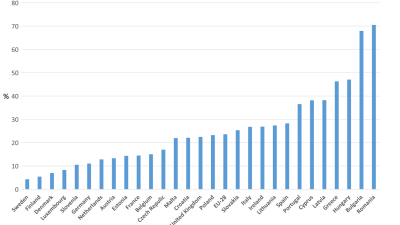Newly updated projections of income poverty among children and working-age adults have been published by the Institute for Fiscal Studies. The projections cover every year to 2017-18, and 2020-21, taking into account knowledge about tax and benefit policy and current forecasts for the macroeconomy.
Although produced for the Northern Ireland Executive, the projections cover the whole of the UK as well as including detailed figures for England and Wales (combined), Scotland and Northern Ireland.
Key points
- In the short run, the report projects an increase in income poverty among children. According to both the absolute and the relative low-income measures, child poverty is projected to increase in each year. Relative poverty is projected to rise by less – because of expected falls in the median income, and hence the relative poverty line. Nonetheless, much of the reduction in relative child poverty seen during and immediately after the recession will be reversed.
- Smaller rises are projected in working-age non-parent income poverty. Again, the increase is greater using the absolute rather than the relative low-income measure, because projected real falls in median income reduce the relative poverty line. The smaller rise in poverty for working-age childless people is likely to be due to their lesser reliance on income from benefits, which is being cut.
- Increases in income poverty are projected to slow down or stop between 2013-14 and 2016-17 as universal credit is phased in, increasing the incomes of low-income families. But beyond 2016-17, continuing increases are expected in relative and absolute income poverty among both children and working-age non-parents.
- Relative child poverty is projected to increase by 5.1 percentage points between 2011-12 and 2020-21, reversing all of the reductions between 2000-01 and 2010-11. In 2020-21, child poverty is projected to be 22.5 per cent and 27.9 per cent using the relative and absolute low-income measures respectively (before housing costs), well above the statutory targets of 10 per cent and 5 per cent.
- This translates into increases across the decade of 900,000 in the number of children in poverty according to the relative low-income measure, and 1.4 million according to the absolute low-income measure.
Source: James Browne, Andrew Hood and Robert Joyce, Child and Working-Age Poverty in Northern Ireland over the Next Decade: An Update, Briefing Note 144, Institute for Fiscal Studies
Links: Briefing note | TUC blog post



 PSE:UK is a major collaboration between the University of Bristol, Heriot-Watt University, The Open University, Queen's University Belfast, University of Glasgow and the University of York working with the National Centre for Social Research and the Northern Ireland Statistics and Research Agency. ESRC Grant RES-060-25-0052.
PSE:UK is a major collaboration between the University of Bristol, Heriot-Watt University, The Open University, Queen's University Belfast, University of Glasgow and the University of York working with the National Centre for Social Research and the Northern Ireland Statistics and Research Agency. ESRC Grant RES-060-25-0052.






